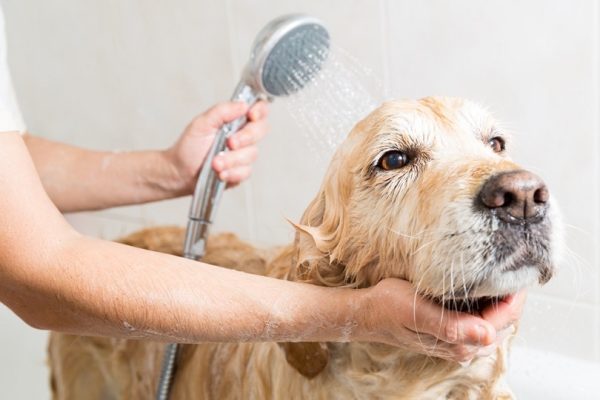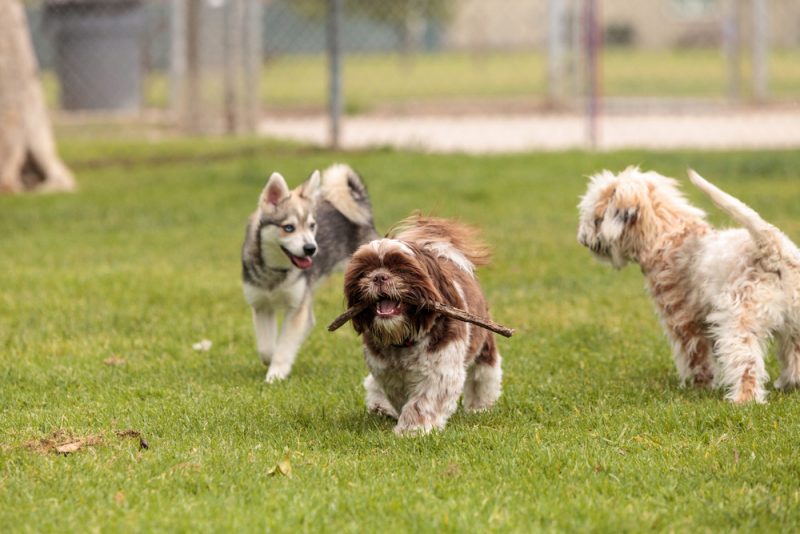In this article
View 8 More +Among dogs, there are few with such a striking coat and valiant personality as the Norwegian Elkhound. This stoutly compact athlete was bred for their dauntlessness and distinctive gray and black-tipped fluffy double coats reminiscent of gray wolves. Originally bred to hunt elk and moose, the Norwegian Elkhound makes a loving family guardian for any household daring enough to keep up with their independent hijinks and occasional stubborn streak.
Join us below as we wade into a bit more about this breed, including what they’re like and how to best care for them.
Breed Overview
Height:
18 to 21 inches
Weight:
45 to 60 pounds
Lifespan:
12 to 15 years
Colors:
Gray, silver, black, white
Suitable for:
Highly active families with older kids, highly active singles
Temperament:
Alert, social, affectionate, intelligent, friendly
Despite being called a hound, the Norwegian Elkhound is in fact a spitz-type dog related to the Siberian Husky and Pomeranian. Like those breeds descended from ancient sled dogs, the Elkhound has a cheery, fluffy, and curled tail and a thick double coat. They were just known as hounds for their superior tracking abilities and, in fact, have no relation to hound-type dogs like the Bloodhound.
Norwegian Elkhound Characteristics

Norwegian Elkhound Breed Puppies

The Norwegian Elkhound is a very rare breed outside and even inside Norway, and you’ll have a devilish time finding a good breeder that specializes in them. Your best bet is the breed’s fan club: the Norwegian Elkhound Association of America.1 The NEAA regularly hosts regional social events where you can meet Elkhound owners and network to find reputable breeders. You can also try the AKC marketplace, which connects you with accredited breeders nationwide.
It can be very tricky to tell good breeders from dishonest puppy mills, especially if you’re a first-time dog owner. You can glean a lot about them online sometimes, but to really find out you have to do some homework and sleuthing. Let’s check out some tips for telling good breeders from breeders you should run and not walk away from.
Tips for Finding an Ethical Norwegian Elkhound Breeder:
- Visit the facility: Good breeders welcome visitors to their facilities. Is it clean, spacious, and well-lit or dim, cramped, and dirty? These are all things to consider.
- Ask to see the parents: If they’re on-site, you can meet them to get a glimpse of their personality, but even photos of your puppy’s parents can give you an idea of what they’ll look like in adulthood.
- Ask for papers: Reputable breeders have AKC papers and health records on hand for you to inspect and ensure your puppy has a clean bill of health.
- Don’t be shy: Ask any and all questions you may have about the puppies, parents, breed, their health, or even about what they’re like to own—breeders are happy to help!

Temperament & Intelligence of the Norwegian Elkhound 🧠
Norwegian Elkhounds are a bit more independent than other dogs, but they’re among the most reliable and lively companions you can have. They’re full of boundless energy and curiosity to accompany you on your errands or the most arduous winter hikes, and they’re very social once they bond with you. Elkhounds are vocal about expressing their enthusiasm or disapproval, and they have no love for strangers either. They make fine guardian watchdogs with some obedience training.
This breed is prideful and stubborn at times, making them better suited for experienced dog owners. They’re super smart and trainable with patience and respect, but they don’t tolerate any nonsense! Norwegian Elkhounds are dynamic dogs that will make sure things don’t ever get too boring, and they need action to be happy. Most of all, they love being with their family and can be quite social when they relax.
Are These Dogs Good for Families? 🏠
Yes, Norwegian Elkhounds can make good family pets if you have older children or teenagers. We wouldn’t recommend them for those with small kids because they can play too. However, it is possible with stringent supervision. Elkhounds are very lively and will definitely encourage a more active lifestyle if you don’t already lead one!

Does This Breed Get Along with Other Pets? 🐶 😽
Yes, but only other dogs. Norwegian Elkhounds can be sort of aloof toward other dogs at first, but extensive socialization can help them come out of their shell and become a very social family-oriented dog. They have a strong prey drive that makes cats a poor roommate, and smaller prey animals like guinea pigs or bunnies are at risk as well. If you have them, keep them in a separate room inaccessible to your dog and in a closed habitat.

Things to Know When Owning a Norwegian Elkhound:
Food & Diet Requirements 🦴
Elkhounds are high-octane dogs that need a lot of food, but they have a habit of overeating and need strict portion control. Puppies need puppy food with 28% to 32% protein content, and then to a lower 20% to 24% once they reach maturity. Other major nutrients included in a complete and balanced kibble are carbs like rice and grain, vegetables, fruit, and sometimes fish.
Generally speaking, good kibble provides 100% of everything your dog needs to grow up and lead a healthy life.
Exercise 🐕
Norwegian Elkhounds are highly active dogs that demand at least an hour of vigorous exercise per day. As puppies from 6 to 12 months, you actually want to limit their exercise to lower-impact activities to avoid skeletal and joint deformities like dysplasia. Light running, fetch, and ordinary yard antics should be fine, and you can try watersports too for a good low-impact activity the Elkhound will love. They’re adventurous at heart and more than happy to try any type of athletic activity at least once!
As a very smart breed, the Elkhound will need mental stimulation to keep them sharp and tire out that intrepid brain. Regular training sessions help encourage critical thinking and patience but won’t suffice alone. We suggest puzzle feeders to manage their penchant for overeating, and mental games, like hide and seek or obstacle courses, help tucker them out too.
Indoors, you can turn to stuffed Kongs to wile away bored afternoons or pack snuffle mats with kibble to make mealtime more enticing.

Training 🦮
Norwegian Elkhounds can be willful and challenging for inexperienced dog owners, but it’s doable with grit and patience. You’ll need lots of positive reinforcement and a big bag of treats too! They become very trainable when you find the right treat to make it worth their while. Start with short training sessions for basic commands like sit. If they sit, shower them with praise and a treat to begin building a positive association with the action. Remain patient and keep the sessions short, as their attention span is shorter than you’d think!
Socialization in the key 4-to-16-week period is vital to forming a more polite, confident dog that won’t be fearful and aggressive at everything that moves in their sight. Elkhounds need your help to learn about the world in a controlled, on-the-leash manner. Ignore nuisance barking at other dogs or squirrels and stand stock still at any leash tugging to make it understood that it won’t get them anywhere.
When they calm down and exhibit behavior like curiosity or playfulness, reward them heavily to help them understand that unfamiliar things are exciting and not scary.

Grooming ✂️
Norwegian Elkhounds have a thick, fluffy double coat that sheds moderately throughout the year but very heavily during spring and fall shedding seasons. Invest in a sturdy double-sided brush with pins on one side for detangling matted fur and a soft side for light de-shedding and redistributing skin oils through the fur.
As you can imagine, they can get quite unkempt if you neglect regular grooming, so make sure to stay on top of it. Baths should be every 6 weeks or as needed with a gentle, high-quality dog shampoo when they get visibly dirty.
Health and Conditions ❤️
Broadly speaking, Norwegian Elkhounds are healthy among large breeds when cared for properly and sourced from reputable breeders. However, you can’t screen out 100% of inherited health problems, and the Elkhound is victim to a distinctive set of them more often than other breeds. Let’s review some of those common health problems below so you can be more informed.
- Skin cysts: This breed is prone to developing sebaceous skin cysts when skin oils block pores, which makes good grooming a must.
- Progressive retinal atrophy: This incurable condition starts by affecting low-light vision and eventually causes total blindness. It is more common in older Elkhounds.
- Kidney problems: Norwegian Elkhounds are vulnerable to kidney diseases that can strike at a young age, so make sure to have your dog screened every year.
- Obesity: Most Elkhounds will happily become obese if allowed to free-feed, which can exacerbate a multitude of other, more serious conditions.

Male vs. Female
Male Elkhounds measure a little larger than females. Males grow from 20 to 21 inches tall and 55 to 60 pounds, whereas females hover at 19 to 20 inches tall and 45 to 50 pounds. There aren’t any noticeable personality differences between the two, and every dog has their own unique quirky personality worth loving.

3 Little-Known Facts About the Norwegian Elkhound
1. Norwegian Elkhounds Are Viking Dogs
Norwegian Elkhounds are one of the most ancient dog bloodlines in the world, and skeletons resembling them have been unearthed alongside 5,000 B.C. Vikings across Scandinavia. Their lineage has remained pure through all these years through insular breeding practices, and dogs are rarely exported.
2. Norwegian Elkhounds Are Born Big Game Hunters
Elkhounds were actually bred to hunt moose, despite the name. They have a rugged, cold-hardy coat, high endurance, and an uncanny talent for tracking. They were mostly bred to work off-leash to locate game and signal to hunters, but they sometimes work on-leash as well.
3. The National Dog of Norway
The Norwegian Elkhound is distinguished as the national dog of Norway, and supposedly, the Prime Minister can “activate” all of them for military service in times of great need. They truly have a sterling reputation no matter where they go!


Final Thoughts
Norwegian Elkhounds are a rare and sadly unappreciated breed with a passionate, social personality and intense athletic drive. They can take some work to train and socialize but mellow out into a marvelously versatile furry family guardian at home in any cold climate.
Featured Image Credit: Vladimir Berny, Shutterstock


















